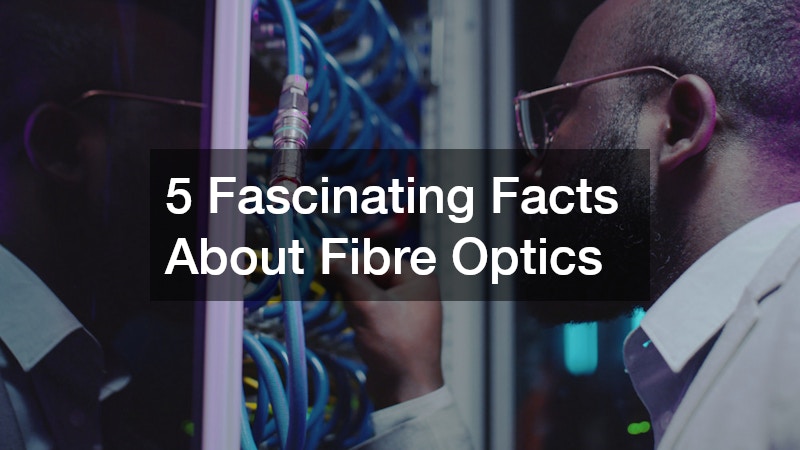Fibre optics play a pivotal role in modern communication, transforming the way information is transmitted across the globe. From the speed of the internet to medical advancements, these slender strands of glass or plastic have revolutionised industries and everyday life. Their impact extends well beyond fast downloads and crystal-clear video calls.
At their core, fibre optics work by transmitting light signals through ultra-thin fibres, allowing for the rapid and secure movement of data. This technology underpins everything from global financial systems to remote surgical procedures, yet most people only encounter it as a faster broadband option. The science behind it is as intriguing as its practical uses.
But beyond their practical applications lies a fascinating world of science and innovation. Here are five captivating facts about fibre optics that highlight their remarkable impact and potential.
1. Light Travels Faster Through Fibre Than Electricity Through Copper
One of the most striking features of fibre optics is their ability to transmit data using light signals. Unlike traditional copper cables that rely on electrical impulses, fibre optic cables utilise pulses of light generated by lasers or light-emitting diodes (LEDs). Light travels at approximately 299,792 kilometres per second in a vacuum and even when slowed slightly by the glass or plastic core, it still outpaces electrical signals by a wide margin.
This speed advantage enables fibre optic networks to deliver extremely fast internet connections, often exceeding 1 Gbps and ensures minimal latency in communication. This is particularly valuable for applications like video conferencing, streaming and real-time online gaming, where every millisecond counts.
2. They Are Immune to Electromagnetic Interference
Unlike copper-based cables, fibre optic cables are not affected by electromagnetic interference (EMI). EMI is commonly caused by nearby electronic devices, power lines or even weather conditions like lightning. In copper wiring, EMI can distort or disrupt the data being transmitted, potentially resulting in slow speeds or corrupted files.
Fibre optics, however, transmit light instead of electricity, making them impervious to such disturbances. This immunity allows fibre to be deployed in environments with high electromagnetic activity, such as industrial settings, airports and medical facilities, without sacrificing signal quality or speed. Additionally, this resilience enhances security, as fibre optic cables are more difficult to tap without detection.
3. Fibre Optic Cables Can Transmit Over Long Distances Without Signal Loss
Fibre optic technology offers significantly lower attenuation—or signal loss—than copper wiring. As light travels through the core of a fibre optic cable, it undergoes very minimal degradation, allowing the signal to travel vast distances without the need for frequent amplification.
For instance, single-mode fibre can transmit data over 40 kilometres or more without significant loss, making it ideal for long-haul communication networks and undersea internet cables. This efficiency is one reason why fibre optics have become the backbone of global telecommunications infrastructure.
Furthermore, with the use of optical amplifiers and wavelength-division multiplexing (WDM), fibre optics can carry vast amounts of data over thousands of kilometres, supporting the ever-growing demand for faster and more reliable internet services.
4. Fibre Optics Are Crucial in Modern Medicine
Beyond communication, fibre optics have become invaluable in the field of medicine. One of their most significant applications is in endoscopy—a procedure that uses a thin, flexible tube equipped with a fibre optic camera to examine internal organs. This technology allows for non-invasive diagnostics and surgeries, reducing patient recovery time and improving accuracy.
Fibre optics are also used in laser surgeries, phototherapy for cancer treatment and biomedical sensors that monitor vital signs in real-time. Their flexibility, precision and immunity to electrical interference make them ideal for use in sensitive medical environments.
The integration of fibre optics in healthcare demonstrates their versatility and life-saving potential beyond traditional networking uses.
5. The Core Is Thinner Than a Human Hair—But Incredibly Strong
Despite being thinner than a strand of human hair—about 8 to 10 microns in diameter—the core of a fibre optic cable is remarkably durable. The strength comes from the combination of the glass core, cladding, protective coating and often, layers of reinforced materials like Kevlar.
This layered construction allows fibre optic cables to withstand harsh conditions, from underwater environments to high-stress industrial installations. In fact, fibre optic cables are commonly used in oil and gas exploration, where they must endure extreme temperatures and pressures while delivering accurate sensor data.
Their compact size also means they take up less space and are easier to install in tight or crowded infrastructure settings, contributing to their widespread adoption across multiple industries.
Why Fibre Optics Are Shaping the Future
Fibre optics represent a marvel of modern engineering, combining speed, durability and versatility in a compact form. Whether enabling high-speed internet access, improving medical diagnostics or supporting international communications, fibre optics are central to how we connect and interact with the world.
As technological demands continue to grow, so too will the need for faster, more reliable networks—making fibre optics not just a modern convenience, but a critical component of our global future. Their unique properties ensure they will remain at the forefront of innovation for years to come.
.




